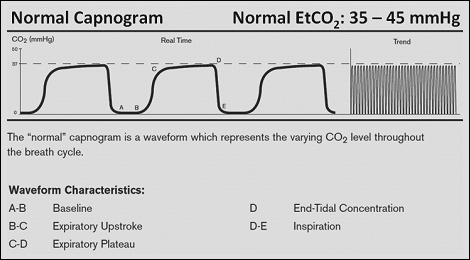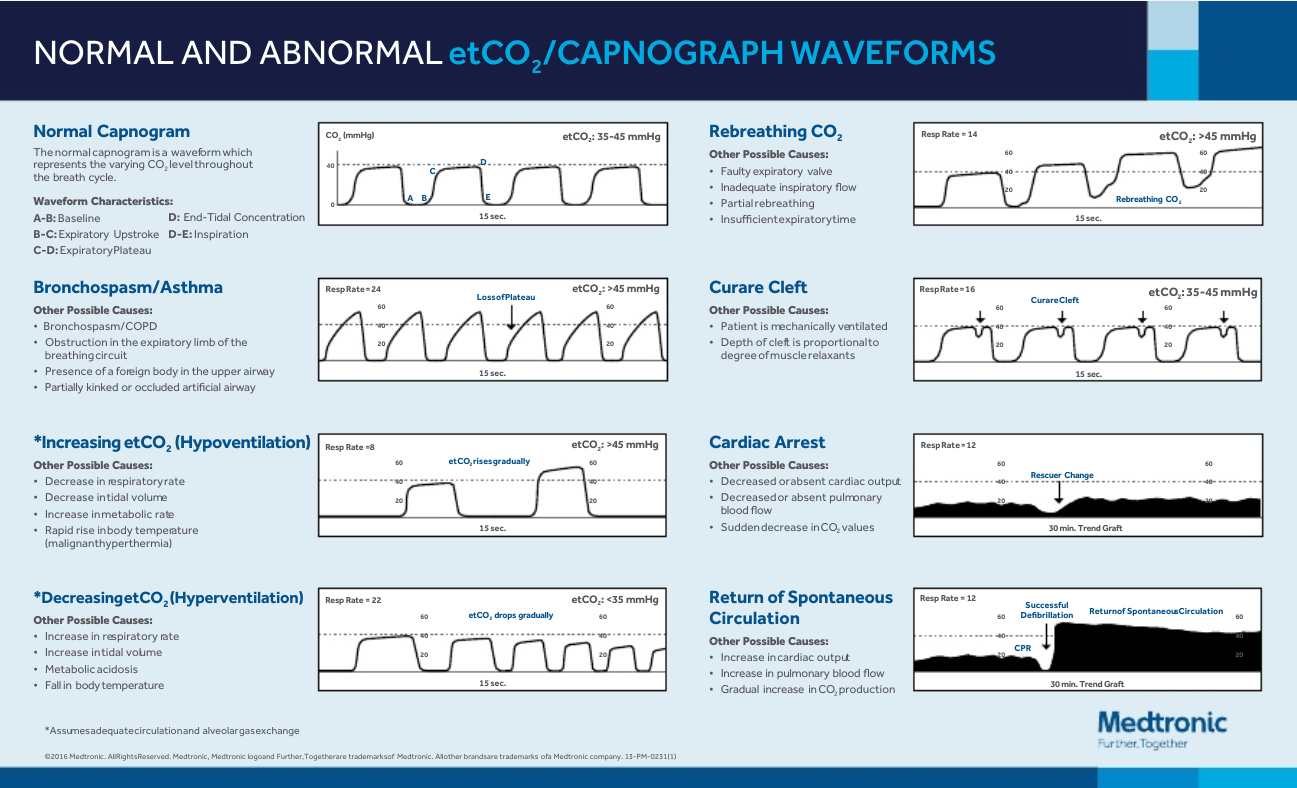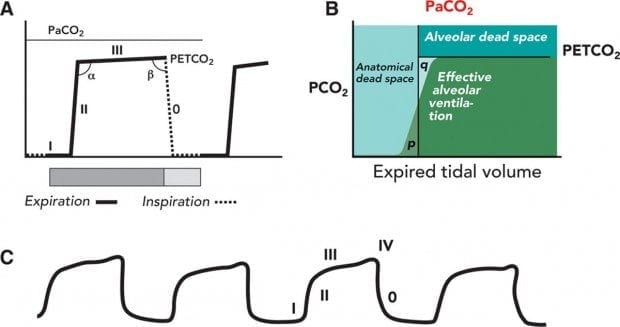end tidal co2 meaning
Since problems with lungs are not common and gas exchange between alveoli and the blood is swift and effective. In fact its commonly called the ventilation vital sign.

End Tidal Co2 Monitoring In The Pre Hospital Environment More Than Just Endotracheal Tube Placement Confirmation Journal Of Paramedic Practice
Capnometer the numeric measurement of CO2.
. Available evidence has established that ETCO2 measurement can provide an indication of cardiac output and pulmonary blood flow24 Non. Total pressure of a gas is the sum of the partial pressures of the gas Expired CO2 measured PetCO2 mmHg in waveform Percentage Normal Levels PaO2 85-100mmHg PaCO2 35-45mmHg Percentage vs. An end-tidal capnography waveform is a simple graphic measurement of how much CO 2 a person is exhaling.
2 See Figure. End Tidal CO2 ETCO2 or PetCO2 - the level of partial pressure of carbon dioxide released at end of expiration. The end-tidal carbon dioxide was 67 mmHg at the time of the blood gas sampling.
This monitoring is often employed in PACU and procedurepost procedure areas. ETCO2 emergency department monitoring and critical. This non-invasive monitor can give valuable information about cardiac output perfusion and ventilation.
End-tidal pertaining to or occurring at the end of exhalation of a normal tidal volume. End-tidal carbon dioxide monitoring ETCO2 has clinical uses far beyond solely determining hypo- or hyperventilation. Most medical sources define hypocapnia as less than 35 mm Hg for partial CO2 pressure in the arterial blood.
In this study the aim was to review the applications of end-tidal carbon dioxide ETCO2 monitoring in emergency department multiple databases were comprehensively searched with combination of following keywords. Capnography can be used to measure end-tidal CO 2. What Does An Increase In End-tidal Co2 Mean.
Capnogram the wave form. End-tidal carbon dioxide ETCO2 is the level of carbon dioxide that is released at the end of an exhaled breath. The end-tidal capnography is used by emergency physicians and paramedics to determine the respiration of the patient.
Definition of Low CO2 hypocapnia Hypocapnia hypocapnea also known as hypocarbia is defined as a deficiency of carbon dioxide in the arterial blood. Oxygenation Versus Ventilation Oxygenation is how we get oxygen to the tissue. 11172009 4 Measuring End Tidal CO2 Daltons Law.
End tidal CO 2 monitoring is represented as a number and a graph on a monitor. The waveform is called capnograph and shows how much CO 2 is present at each phase of the respiratory cycle. End tidal CO 2 EtCO 2.
Capnograph is an indispensable tool for monitoring metabolic and respiratory function. The creatine kinase was 1200 IUl and the partial thromboplastin time was normal. ETCO2 levels reflect the adequacy with which carbon dioxide CO2 is carried in the blood back to the lungs and exhaled.
In conditions of normal breathing 6 Lmin 12 breathsmin 500 ml for tidal volume etCO 2 is very close to alveolar CO2. This causes CO2 to accumulate in the lungs and more of it to be excreted with each breath hypercapnea which would cause the ETCO2 level to rise. Capnography waveforms etCO2 and breathing patterns.
It is the measurement of CO2 at the completion of exhalation and roughly correlates to the CO2 present in arterial blood. In other words a high ETCO2 is a good sign of good ventilation while a low ETCO2 is a sign of hypoventilation. End Tidal CO 2 6 Can also be measured and monitored in spontaneously breathing patients via nasal cannula or mask see pictures below Same connectors and monitor would be used as seen on previous slides.
The number is called capnometry which is the partial pressure of CO 2 detected at the end of exhalation ranging between 35 - 45 mm Hg or 40 57 kPa. Diagnosis of Increasing End-tidal Carbon Dioxide. 78 Nitrogen 21 Oxygen 1 CO2 and other gases Exhaled gases.
MmHg Relate to the air we breath. End-tidal capnography or end-tidal CO2 EtCO2 monitoring is a non-invasive technique that measures the partial pressure or maximal concentration of carbon dioxide CO2 at the end of an exhaled breath. Also called capnometry or capnography this noninvasive technique provides a breath-by-breath analysis and a continuous recording of ventilatory status.
This is a major respiratory symptom. The normal end-tidal capnography wave form is basically a rounded rectangle. Capnography the measurement of carbon dioxide CO2 in exhaled breath.
Secondly what does low etco2 mean. Of or relating to the last portion of expired tidal air End - tidal carbon dioxide monitors are already being used and are recommended to indicate the adequacy of cardiopulmonary resuscitation and the likelihood of a successful resuscitation. End-tidal carbon dioxide ETco 2 monitoring provides valuable information about CO 2 production and clearance ventilation.
The amount of CO2 at the end of exhalation or end-tidal CO2 ETCO2 is normally 35-45 mm HG. Medical Definition of end-tidal. The ETCO2 is the amount of carbon dioxide CO2 exhaled from ventilationd air.
ETCO2 is the amount of carbon dioxide CO2 in exhaled air. Carbon dioxide is produced in cells and after diffusing into the blood it is transported to the lung for excretion.

R Series Advanced Monitoring Capnography Waveforms Zoll Medical
The Normal Capnograph Waveform Deranged Physiology
Riding The Wave Of Capnography Understanding Etco2 Vetbloom Blog

Waveform Capnography In The Intubated Patient Emcrit Project

Basic Capnography Interpretation Nuem Blog

Normal And Abnormal Capnography Waveforms Infographic Capnoacademy Capnoacademy


